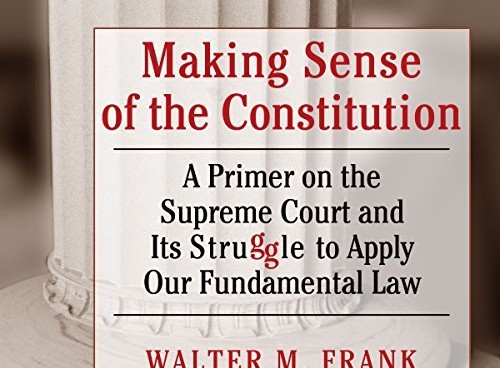“Making Sense of the Constitution ” Makes Sense for General Readers

“Making Sense of the Constitution: A Primer on the Supreme Court and its Struggle to Apply Our Fundamental Law,” Southern Illinois University Press, 2012
There are dozens of books written for the general public that summarize the things people need to know about the United States Constitution and the Supreme Court. Some of them are quite good, but the one to read about making sense of the constitution is this one by Walter M. Frank.
The first part of the book, like many others on the subject, summarize the Constitution and place the articles and amendments in their historical context. This one does it without any particular bias. Instead, the author takes great care to present the material in an objective manner—as objective as possible given the subject.
Frank singles out the most important Supreme Court opinions for analysis and presents them without getting the reader lost in too much detail. In most cases, he does an excellent job demystifying some of the popular notions of the Constitution through his presentation of the cases he chooses to highlight.
While the first half of the book contains everything you would expect in a book about the Constitution, the second part of the book does much more. Frank explains constitutional interpretative theory in the simplest and most understandable way that I have read thus far.
This section of the book begins with an outline of nine leading theories of constitutional interpretation by using the narrative technique of asking candidates to the Supreme Court to write a letter to the President about their thought process. Each theory is then discussed in more depth as the author identifies the theory and its leading exponents.
This is the part of the book that makes it stand out above the others. While some authors weave constitutional theory throughout the book, it is never quite so clearly explained as Frank explains it. Neither will readers ever encounter a discussion of the various theories of constitutional interpretation as thoroughly in a book targeted to a general audience.
Admittedly, I was not initially inclined to buy this book. The title is a bit daunting and the cover is graphically boring. Worse still, since its publication in 2012, it has received only one review on Amazon.com and the publisher chose only academics to praise the book. The sample provided for the e-book version isn’t particularly helpful, either. The sample in this case is enough to let you know that Frank is a good writer and that the book is a general audience book, but it is not enough to show how this book is different from a dozen others just like it.
While these “judging a book by its cover” items are not important at all, they do explain why many people haven’t “discovered” it yet. Frank’s book compares favorably to the more widely read, classic general reader book on the subject by Michael Stokes Paulsen and Luke Paulsen, “The Constitution: An Introduction.” However, Frank’s book goes into a bit more depth in certain areas. Both books are well written and easy to understand, but I give the edge to Frank.
